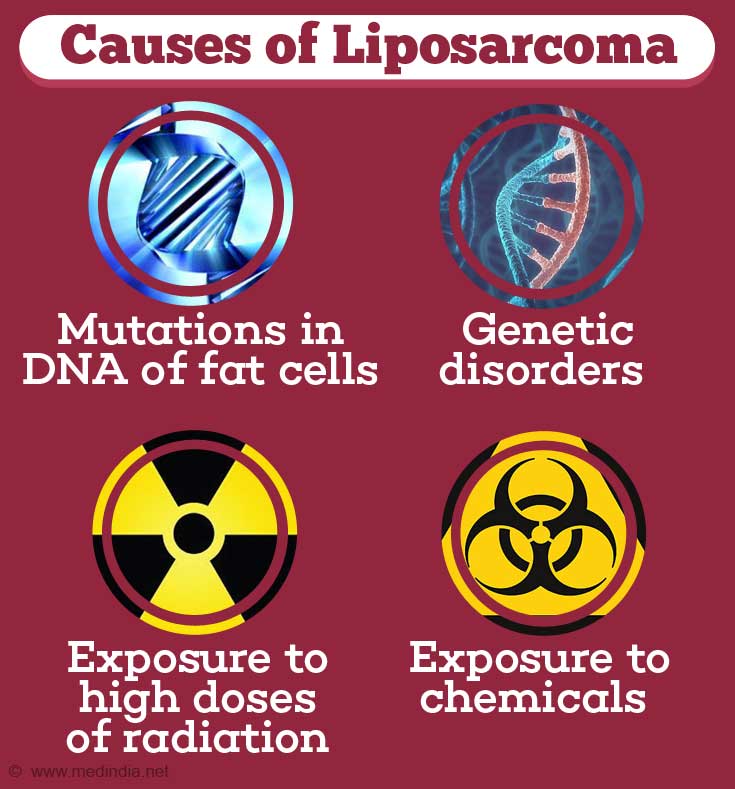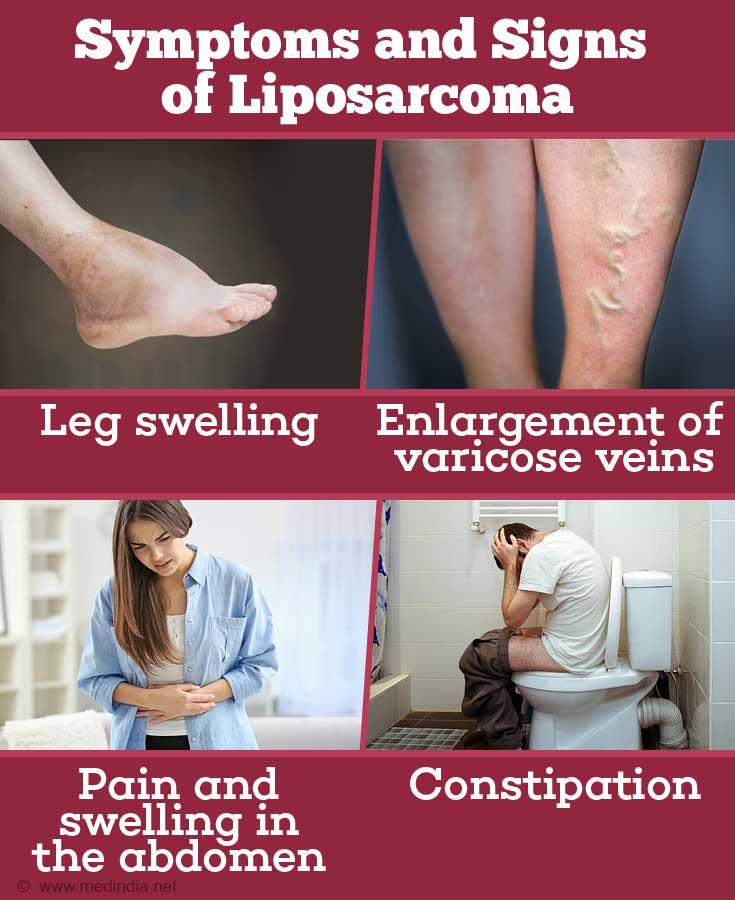- What is liposarcoma? - (http://sarcomahelp.org/liposarcoma.html)
- Learn About Liposarcoma - (https://radiopaedia.org/articles/liposarcoma)
- Liposarcoma - (https://en.wikipedia.org/wiki/Liposarcoma)
- Overview Liposarcoma - (https://www.mayoclinic.org/diseases-conditions/liposarcoma/symptoms-causes/syc-20352632)
- Sarcoma Foundation - (https://www.curesarcoma.org)
- What’s New in Liposarcoma? - (https://www.mskcc.org/blog/what-s-new-liposarcoma)
- Liposarcoma: a soft tissue tumor with many presentations Mankin HJ1, Mankin KP, Harmon DC. Musculo skelet Surg. 2014 Dec; 98(3): 171-7. - (https://www.curesarcoma.org)
- Managing Liposarcomas: Cutting Through the Fat. J Oncol Pract. 2016 Manji GA1, Schwartz GK2 Mar;12(3): 221-7 - (https://www.curesarcoma.org)
- Application of molecular biology to individualize therapy for patients with liposarcoma. Abbas Manji G1, Singer S1, Koff A1, Schwartz GK1. Am Soc Clin Oncol Educ Book. 2015: 213-8 - (https://www.curesarcoma.org)
- Recent advances in the management of liposarcoma Nadar A. Nassif, William Tseng, Camille Borges, Peter Chen, Burton Eisenberg F1000 Research 2016, 5 (F1000 Faculty Rev): 2907 - (https://www.curesarcoma.org)
What is Liposarcoma?
Sarcomas are cancers arising from tissues such as muscle, bone, fat, blood vessels and connective tissue such as cartilage, tendons and ligaments.
Liposarcoma is a rare cancer arising from fat cells and is considered to be a type of soft tissue tumor. It accounts for up to 18% of all soft tissue sarcomas. It can occur in fat cells anywhere in the body, but most of the liposarcomas occur in the muscles of the abdomen and limbs. Generally, liposarcoma affects adults but it can also occur during the teenage years.
What are the Different Types of Liposarcoma?
Liposarcoma is subdivided into four types, each having unique behaviors and characteristics.
Well-differentiated liposarcoma: It is the most common subtype and generally starts as a low grade tumor where cells look very much similar to normal fat cells and they grow and change very slowly.
Myxoid liposarcoma: It is an intermediate to high grade tumor and cells look less normal under the microscope and may have a high grade component.
Pleomorphic liposarcoma: It is the rarest subtype and is an aggressive tumor that spreads to other parts of the body. It is a high grade tumor with cells that look very different from the normal cells.
Dedifferentiated liposarcoma: It is a tumor of aggressive type and occurs when a low grade tumor changes, and the newer cells in the tumor are high grade.
What are the Causes of Liposarcomas?
In spite of recent advances in cancer and molecular biology, the precise reason for liposarcomas is still not known. In few cases, liposarcomas have been reported following injury but trauma is not considered to be a cause of liposarcoma. Lipomas (benign tumor of fat tissue) are harmless clumps of fat and do not develop into liposarcomas.
However, there are several risk factors which have been found to be associated with liposarcomas.
These risk factors are as follows:
- Mutations in DNA of fat cells are associated with liposarcomas. Usually, these mutations are acquired rather than being inherited and can turn the oncogenes on or turn off the tumor suppressor genes.
- Certain genetic disorders such as tuberous sclerosis, Gorlin syndrome, Gardner syndrome, Retinoblastoma, Li-Fraumeni syndrome and Werner syndrome may heighten the risk of getting liposarcomas.
- Exposure to high doses of radiation such as given during a previous cancer therapy, diagnosis or accidentally can also give rise to liposarcomas.
- Increased risks of liposarcoma have also been observed in relation to exposure to certain chemicals, including dioxins, vinyl chloride and phenoxyacetic herbicides.
- Sometimes, an association has been observed between liposarcomas and Epstein-Barr virus infection.

What are the Symptoms and Signs of Liposarcoma?
The signs and symptoms of liposarcoma vary depending on the part of the body which is getting affected.
If liposarcoma occurs in the arms and legs, it can cause:
- A growing lump of tissue under the skin
- Pain
- Swelling
- Enlargement of varicose veins
- Weakness of the affected limb
- Nausea
- Vomiting
- Numbness
- Fatigue
- Pain and swelling in the abdomen
- Constipation
- Blood in the stool
- A feeling of fullness while still eating
Retroperitoneal liposarcoma is characterized by extreme weight loss and abdominal pain. Sometimes, they press on the kidney or ureter leading to kidney failure.

How to Diagnose Liposarcoma?
Physical examination: If you observe a lump which is 5 cm or larger, firm and is deep seated, you should consult a doctor who will suggest to go for the following tests and procedures:
- Imaging tests: Generally, doctors may recommend imaging tests such as X-ray, CT, PET scan and MRI to confirm the presence of liposarcoma and its size and extent.
- Biopsy: This means taking out a sample of tissue for testing. During this procedure, the doctor removes a small sample of tissue to test for the presence of cancer cells. Most of the times either a needle biopsy or a surgical biopsy is performed. Immunohistochemistry, cytogenetics, Fluorescent in situ hybridization (FISH) and PCR based genetic tests are some of the recent techniques which are used to test the biopsy samples.
The results from a biopsy and imaging studies provide information about the nature of the tumor, its degree of aggression, extent of the tumor and distant spread if any. These will help in determining the treatment and prognosis.
How do you Treat Liposarcoma?
The following options are used for treating the liposarcomas:Surgery: It is the most common and mainstay of treatment which involves removing the entire tumor and some healthy tissue surrounding it to prevent recurrence. Earlier, amputation was necessary for liposarcomas affecting limbs; but currently only in 5% of patients, amputation is required to remove the tumors affecting the limbs.
Radiation therapy: It involves treating cancer with high-powered beams of energy, such as X-rays or protons and is generally done before surgery to shrink a tumor or after surgery to kill the left over cancer cells if any. Chemotherapy and radiation therapy may be combined.
Chemotherapy: The role of chemotherapy in the treatment of liposarcoma is controversial and is still considered to be experimental without great success. For metastatic liposarcomas or the ones which are not resectable, drugs such as trabectedin (Yondelis) and eribulin mesylate (Halaven) have been recently approved by the U.S. Food and Drug Administration (FDA) to treat the liposarcomas.
Targeted therapy: It has been observed that CDK4 oncogene is amplified in 90% of liposarcoma cases. Treatment with Palbociclib, a potent CDK4/CDK6 inhibitor, has shown activity in well differentiated liposarcoma and dedifferentiated liposarcoma by halting disease progression. Another potential target in liposarcoma is the high amounts of MDM2 amplicon and preliminary studies with RG7112, an MDM2 antagonist, has shown promising results. Further, nelfinavir, a protease inhibitor has been the subject of a clinical trial.

What is the Prognosis of Liposarcoma?
The prognosis of liposarcoma varies depending on the disease subtype. For well differentiated liposarcoma, the 5 year survival rate is 100%, for myxoid liposarcoma, it is 88% and 56% for pleomorphic liposarcoma. For well-differentiated liposarcoma, 10 year survival rate is 87%, 76% for myxoid liposarcoma and 39% for pleomorphic liposarcoma.
However, the prognosis of well-differentiated and de-differentiated liposarcoma depends on the size of the tumor, site of the disease, type of cells involved and proximity to the lymph nodes. If liposarcomas are present within the abdomen, then complete removal of the tumor in the long term is less common as it is extremely difficult for the surgeon to completely remove the tumors from abdomen.
How to Prevent Liposarcoma?
As the exact cause of liposarcomas is not known, it is difficult to prevent them. The only way to reduce risk of liposarcoma is to avoid exposure to the risk factors such as exposure to radiation, chemicals, genetic syndromes and damaged lymph system.
In addition to avoiding the risk factors, one should maintain a healthy life style with no smoking and drinking along with the consumption of plant based foods rich in antioxidants.
Health tips
- As the exact cause of liposarcomas is not known, it is always better to avoid the risk factors.
- Maintain a healthy lifestyle with adequate exercise and a diet rich in fruits and vegetables.
- Do meditation and yoga to reduce stress.
- If you have hereditary or any other predisposing condition, get yourself regularly checked for cancer.
- Stop smoking and reduce alcohol intake.
- Avoid use of cancer-causing food additives such as MSG, food dyes such as Red 40, Yellow 5, and Yellow 6.
- It is preferable to buy organic products as they are free from pesticides and herbicides used in conventional agriculture.
- Regularly consult doctors for managing and reducing the side effects of the chemotherapy.






